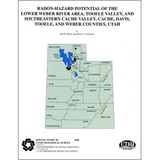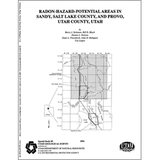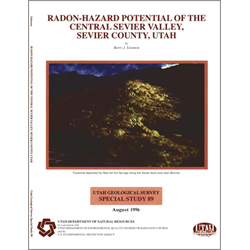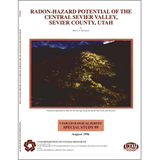Radon-hazard potential of the central Sevier Valley, Sevier County, Utah (SS-89)
By: B. J. Solomon
Radon, a radioactive gas derived from the decay of uranium, occurs naturally in rock and soil. The gas migrates through the ground and, after penetrating foundation openings, can accumulate indoors in sufficient quantities to cause lung cancer. Both non-geologic and geologic factors influence indoor-radon concentrations. The effects of non-geological factors, such as construction type and weather, are difficult to estimate. However, important geologic factors can be measured and their influence evaluated.
The geological factors of uranium concentration, ground-water depth, and soil permeability are characterized for the central Sevier Valley in Sevier County, Utah, an area where indoor-radon concentrations up to 22.4 picocuries per liter are found. Numerical scores were applied to each factor; higher scores correspond to conditions favorable for elevated indoor-radon concentrations. Three radon-hazard-potential categories were established based on cumulative totals of the three factors. The categories indicate the relative potential for elevated indoor-radon levels, and their areal distribution id delineated on a hazard map constructed from overlays for each factor.
Other Information:
Published: 1996
Pages: 48 p.
Location: Sevier County
Media Type: Paper Publication









